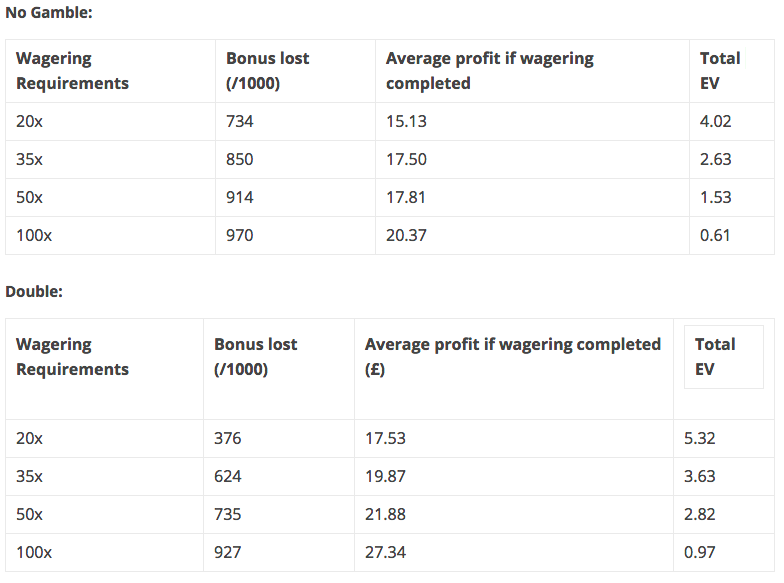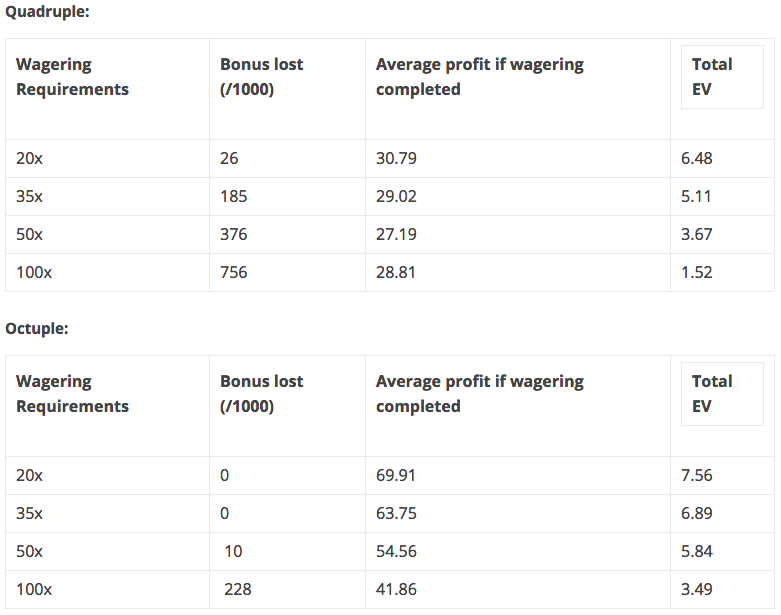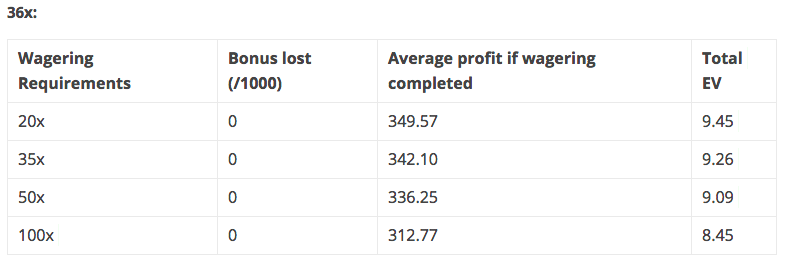This is something I have touched on before but I just thought I would put together a whole post dedicated to it and dive into it in a little more detail. The maths behind two-tier wagering is quite complex and not something I am really qualified to explain although I am going to use a bit of help from an experiment I’ve found on another betting website.
If you aren’t up to speed on what advantage play is then have a read of my explainer page here.
What is Two-Tier Wagering?
When you are handed a casino bonus there is more often than not quite large “wagering requirements”. All this usually means is there is a certain number of times you have to bet the full amount of your bonus before it becomes your own withdrawable cash.
For example, a £10 bonus with x20 wagering requirements means you would have to wager an additional £200 (10 x 20) before that bonus becomes yours to keep. Of course in reality, you either bust out and stop there, or you end up with an amount that can be far larger than £10.
After receiving a casino bonus, there are several different ways in which you can proceed. You can go for maximum lines and minimum stakes if you are on slots, or you can go for low risk bets such as red or black on a Roulette table.
The idea behind two-tier wagering is a very basic one, which is that you increase your stake size at the very start of the wagering requirements in order to achieve a large win which drastically reduces your chance of busting out of the bonus.
This is incredibly hard to predict, especially with slots because there aren’t many (if at all) with fixed pay-outs. However, there have been experiments done with fixed pay-out games such as Roulette to demonstrate how this strategy affects the bust out rate, expected value (EV) and the average profit if the offer is completed.
The Maths Behind Two-Tier Wagering
As I’ve already told you, I don’t understand the maths fully myself so I’ve enlisted a bit of help from the guys over at Edge Your Bets.
I’m going to use their experiment to prove the maths behind why two tier wagering works.
Their data is based on the following presumptions and questions:
“To illustrate a point however we are going to assume a 95% return to player (RTP) expressed as a 15% chance of a 5.33-1 pay-out for the purposes of a simulation.
If we receive a £10 bonus that has 20x, 35x, 50x or 100x wagering requirements and we use 20p spins, what is the chance that we will lose our bonus before completing the wagering requirements?
Furthermore, what is the expected value and chance that we can complete the wagering requirements if we try to multiply our bonus at the start?”
They ran a thousand trials of each and here are the results below:



Their total EV was calculated by the average profit times the chance of the gamble winning, times the chance of not losing the bonus after wagering.
As you can see the results are quite dramatic, and the larger we multiply our original stake the bigger the difference.
The EV for placing a x36 bet (single number on Roulette) is 14 times bigger than just using our original 20p stake when the wagering requirements are 100x. Not only that, they are also a close to zero chance of busting out of the bonus if that bet wins (none of them did in the experiment).
Obviously, the chance of winning something from that bet is small (1/37) at only 2.7%. However, when you look at wagering on 100x with our original stake we only have a 3% chance of making it through wagering anyway.
Which leaves us with a choice. We can either attempt a 3% chance of winning £20.37 or we can have a go at a 2.7% chance of £312.77. I know which one I would prefer to do.
It’s obvious, but I feel I need to state this anyway, that this experiment is missing one very important factor, which is variance. But that shouldn’t make the case any less convincing, it just means there will be more extremes e.g. you may end up with £200 or £1,000 rather than £312.77.
Either way, you still finish with a hell of a lot more than £20.37!
Time Benefits of Two-Tier Wagering
Of course it’s not just bigger potential profits that make two-tier wagering so appealing. It’s also the time-saving element. As a direct result of increasing your bets early on you will obviously bust out a lot more quickly that you would if you were doing the minimum stakes (20p).
Let’s just say you had £400 of wagering to get through on 20p spins, that 2,000 spins you would have to sit through. I’m sure by now you are aware of how long it can take a slot on auto-spin to complete 100 spins, so imagine having to sit through 20 of them!
Of course you can leave the game spinning in one window, but you still have to come back every 10 minutes or so to reload the auto-spin, and it could be a lot more often than that if it’s a Blueprint game like King Kong Cash or TED where you have to reset the auto-spin counter after every bonus round (even if there wasn’t an actual bonus round 😡).
Find a Stake You Are Comfortable With
So there you have it, the benefits of two-tier wagering are clear to see. Not only are you likely to reap much bigger rewards you also likely shave large amounts of time spent on your phone, computer or laptop staring at spinning slots. Just be clear I still advocate maximum lines and minimum stakes for initial wagering, but when it comes to the bonus, you will need to increase that stake size.
Now obviously not all of you (myself included) will have the stomach for taking several bust outs in a row before (hopefully) hitting a huge win that covers them all and then some. So why not start small by doubling your stake?
As you can see although you will only marginally increase your potential average profit and EV, however if you are just one of those small £5 bonuses with x20 wagering look at the bust out rate, it almost halves from 734 to 376!
Then once you got your feet wet and you are comfortable with the increased bust outs you can look a quadrupling it. Which if you win, will almost eradicate the chance of busting out of your bonus on a 20x wagering requirement.
Conclusion
Hopefully you enjoyed this guide and learnt a bit about two-tier wagering. If you enjoyed this article, you may find my posts on variance and EV interesting. Or if you are ready to give two-tier wagering a go why not try my exclusive offer with Gala Spins here.
